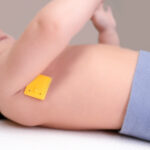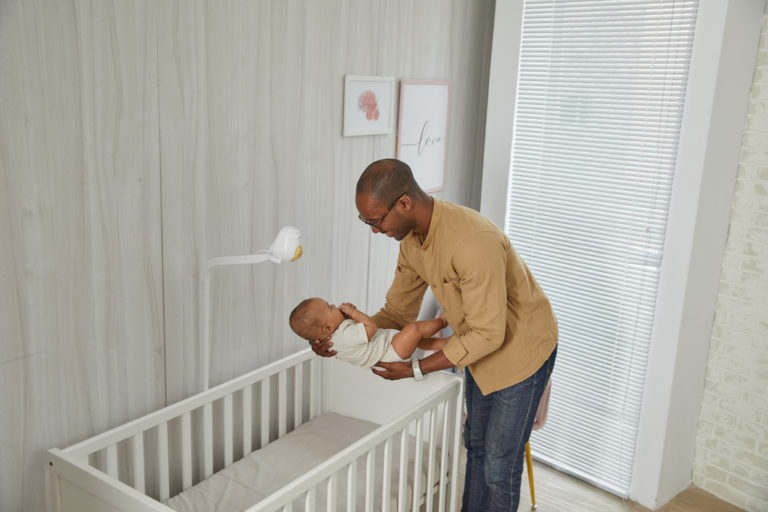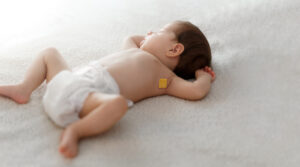Since co-sleeping is related to increasing the risk of SIDS (infant death syndrome), we do not recommend co-sleeping with your baby. If you’re struggling to get your little one to sleep on their own, you might start wondering when and how to transition them to the crib.
While many moms and dads have gone through this big move before you, this isn’t exactly an instinctual skill that just comes out of thin air. In fact, it’s natural for many parents to worry about this transition. The anxiety of new mothers is normal and there is no shame in dealing with anxiety as a new parent as you are also going through a transition yourself. If you are a new mom struggling with postpartum depression, there are also plenty of resources online about postpartum symptoms and treatment that you can access.
Now, as you welcome your little bundle of joy, you surely have a lot of questions as a new parent such as how to transition your baby to the crib or when to transition baby from a crib to their own room.
To answer all of your questions about this big move, in this post we will be talking about when to transition baby to crib, and how to do it using a smart baby monitor in the most efficient way possible, some tips and sleep FAQs.
Before jumping into how to transition to crib, first you need to know when to do so.
Why is co-sleeping dangerous for your baby?
Co-sleeping in the same bed does pose a number of issues for the baby’s safety. For instance, there’s the risk of accidentally suffocating them. These risks are especially high for babies younger than 3 months.
As your baby’s nose and throat are still too small for regulating proper airflow, they are most likely to have difficulties breathing when their face gets covered by bedding. They might also experience difficulty breathing if you roll over onto them while they are sleeping next to you.
A couple of other common risks that babies face with co-sleeping are the lack of space or room for growth since they sleep in a tight cuddle against your body. There’s also the risk of falling out of bed which can lead to injuries such as broken bones or concussions.
According to Dr. Sherman Silber, the director of the Infant Crib Death Institute, this is due to indiscriminate sleeping practices where parents place their babies on their sides or backs to sleep. This creates a breathing obstruction that might lead to suffocation or even SIDS (sudden infant death syndrome). In fact, the CDC estimates that over 3,400 babies die from sudden unexpected infant deaths in the United States with accidental suffocation and strangulation as one of the top causes.
On the other hand, if you’re still hesitant about letting your baby sleep in their own room, you can opt for room sharing instead. Lots of parents sleep with their baby in the same room for months until they’re able to sleep for longer periods of time. Ideally, anywhere between the 6-7 month mark is a good time to transition the baby to their own room. Nonetheless, if you’re still worried about letting your baby sleep in another room, you don’t have to, because you can still keep an eye on your baby with the Smart Baby Monitor HD Night Vision.
When to transition from a bassinet to a crib
Your baby’s weight and size are indicators of whether they’ve outgrown their bassinet. If they’re starting to look kind of cramped in their bassinet, it’s definitely time for an upgrade to make them feel more comfortable.
Apart from this, there are also other developmental signs.
For instance, if your baby is rolling over, there’s a risk of suffocation when they have their face down but do not have enough strength to roll back onto their backs. This is why during the transition, having a smart baby monitor that provides face-covered alerts and rollover detection can act as an extra set of eyes to look out for your baby’s safety.
How to get baby to sleep in crib after co-sleeping?
To start with the transition, you will need to follow a set schedule for the night, as well as during the day, so that your baby will be familiar with the process.
Here are some rules to follow to make the transition easier:
- Make sure your baby has a safe place to sleep and let your baby sleep on their back, remove everything from the crib and keep the room at a comfortable temperature.
- Your bed is off-limits for the first three months after starting the transition
- Sleep Train them to make the transition easier. This can be done in a variety of ways with and without extensive crying such as using the Ferber method. The Ferber method makes use of “progressive waiting” to encourage an infant’s self-soothing. This method involves putting the baby to sleep and leaving the baby alone for increasing amounts of time.
How to transition baby from sleeping in the same room with you to sleeping in their own room?
To start with the transition, you will need to place the crib in a room near your master bedroom. It doesn’t have to be within your sight, but it should still be nearby. Keep the baby monitor on and make sure that the monitor is connected wirelessly or through a USB cable.
Having a safety-focused smart baby monitor can help you along this journey as it will allow you to receive notifications about your baby without interrupting their sleep.
1. Use Your Smart Baby Monitor
A smart baby monitor is basically this generation’s baby monitor. It does all the things that your baby monitor did, say 20 years ago, and so much more.
With your phone, it instantly allows you to not only listen to your baby but also see your baby in real-time. With it, you can:
✅ Talk and sing to your baby with Two-way Audio
✅ View Live Video Feed
✅ Review baby’s Sleep Analytics
✅ Playback video to see your baby’s night
✅ Get notifications for for true cry alert (This isn’t picked up by sudden movement)
✅ Get notifications for when your baby wanders off into designated area (This is the danger zone alert)
Okay, but how does this help with transitioning baby to crib? Glad you asked!
Having a smart baby monitor allows you to have maximum peace of mind since you’re able to see your baby at any time. You don’t have to put your ear up to the door or even worse, walk in and wake them up.
2. Start During the Day
Adjusting your baby’s sleep-schedule during the day is easier compared to doing so at night. When they’re awake and active, they might just feel comfortable in their crib. During the day, some babies also start to realize that a crib is a cozy space. It’s also a good way to slowly introduce your baby to the idea of sleeping by themselves.
You may use blackout curtains to keep the room dark when they are napping during the day. This can help them feel comfortable, making it easier for them to sleep longer in their crib at night. While it doesn’t seem like the best solution, it goes a long way when getting your baby on a schedule that works!
And if you’re using a Smart Baby Monitor, chances are, it has HD Night Vision, so you can still see and monitor them perfectly well day and night, and yes even with the blackout curtains!
3. Create a Nighttime Ritual
Having a nighttime ritual is one of the best ways to prepare your little one for the sleeping adjustment. You can modify it as needed but most moms will feed, bathe, turn the lights down, maybe read a story, and when the baby is starting to get drowsy, set them in the crib. This way, they fall asleep on their own.
Doing this over and over again will create a nightly routine so they know exactly what to expect–and being set in their own crib won’t be any sort of surprise. After getting them situated in their crib, you can either leave them to self-soothe, and watch them from your smart baby monitor, or stay and watch your little one doze off.
4. Use Whatever Method Works For You
From the Ferber method to No-Cry Sleep Solutions there are lots of ways to sleep train according to your and your baby’s needs and preferences. Whatever you choose, sleep training will regulate your baby’s sleep schedules (and hopefully your own).
Maintaining sleep hygiene will help your baby have better and sounder sleep.
Tips on How to transition baby to crib
1. Be patient
As much as you want to get this stage over with, you need to first accept that transitioning to crib won’t be an overnight process. It might take a few nights to get the hang of it but you’ll make it out in one piece. What you need to be the most right now is to be patient with yourself and your little one. This change is for all of you and it might not be entirely successful right off the bat but it will be!
2. Take baby steps

If it is not easy to get your baby to sleep in a crib, we recommend that you start when your baby is more tired. Some days your baby may be more energetic, meaning it might not be a good time to move them to the crib. Once your baby is more comfortable with sleeping in the crib, go ahead and apply whatever methods you use to all naptimes.
FAQs About Transitioning Baby To Crib
Do babies sleep better in their own room?
Of course, we have to start this by saying that not all babies are the same. There’s a lot to take into consideration when considering this question. To answer this question, let’s look into a prominent study whose findings have been key in addressing when to move baby to crib.
According to a study done by St. Joseph’s University, the Children’s Hospital of Philadelphia and funded by Johnson and Johnson, found that the answer is a confident “yes”.Their results showed 37.2% of US infants from 6-12 months, and 48.4% of babies worldwide who slept separately from their parents (in a different room) actually slept better. But what does “better” mean? This means that babies slept for longer stretches of time and woke up less during the night, resulted in longer hours of total sleep.
If you’re not totally sure how long your baby’s stretches of sleep are at night, learn more about tracking your baby’s sleep in numbers.

What is sleep training?
There are different methods of sleep training that work for different families and their children.
But many parents swear by this method since it is one of the most effective ways to get your baby to learn how to fall asleep on their own.
Sleep training is the process of helping your baby get on a schedule that makes them more comfortable in their new sleeping arrangement. To accomplish this, you need to put them to sleep at the same time every day and wake them up at the right time too. When done properly, this creates a routine for babies so they can easily fall asleep by themselves.
A few tips for sleep training include:
- Start by putting your baby to sleep at the same time every night, such as 8 pm.
- Wake them up at the same time every morning, such as 6 am.
- Make sure you keep it consistent and don’t miss a day.
- Keep track of what happens during the day and try to get one full cycle of around 3-1/2 to 4 hours before waking your baby up again (so 1 hour awake + 3 or more hours for sleeping). This lets babies get long stretches of sleep, which is important for them since newborns already need 12-18 hours of total sleep in a 24 hour period!
- Put your baby in the crib while they are still awake so they get used to it.
Finding what works when transitioning your baby to crib
It’s hard to know what will work for your own baby, but no matter how you transition, be consistent and follow it through. We are against co-sleeping and encourage you to make choices that are safe for babies. There are many ways to connect with your baby without co-sleeping. The American Academy of Pediatric recommends babies to sleep in a crib, bassinet or cradle to avoid safety hazards. We hope these tips will help you make the transition as gentle as possible.
- A Must-Read for New Parents: Issues with Baby Spitting Up and Vomiting

- Baby Sleep Guide: Solutions to Four Major Infant and Toddler Sleep Issues

- Decrypting Childhood Asthma: From Causes to Prevention, Insights into Infant and Child Health

- Dealing with Night Wakings in the Warmer Months

- 5 Things I Wish I Knew About Breastfeeding Before Becoming a Mum

- The One Thing Getting in the Way of a Good Night’s Sleep






